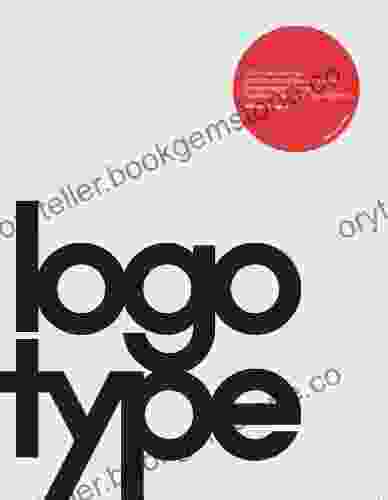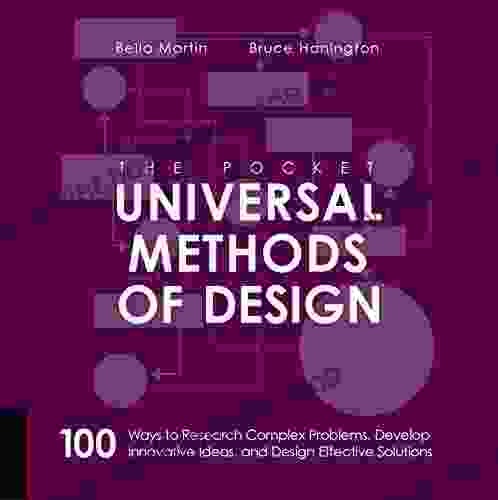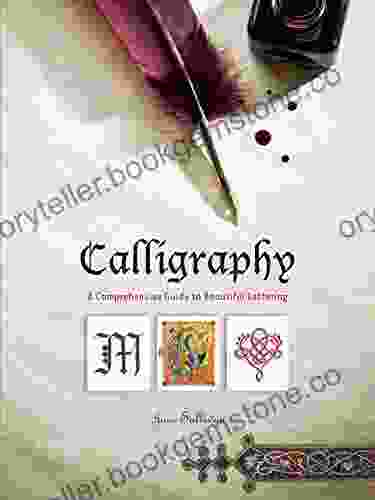100 Ways To Research Complex Problems, Develop Innovative Ideas, And Design Creative Solutions

In today's rapidly changing world, we are constantly faced with complex problems that require innovative solutions. Whether you are a business leader, a scientist, a designer, or simply someone who wants to make a difference in the world, it is essential to have a solid understanding of how to research complex problems, develop innovative ideas, and design creative solutions.
This article will provide you with 100 ways to do just that. These methods are drawn from a variety of disciplines, including design thinking, engineering, psychology, and business. By following these tips, you can improve your ability to solve complex problems, generate innovative ideas, and design creative solutions that will make a positive impact on the world.
1. Define the problem.
4.4 out of 5
| Language | : | English |
| File size | : | 22462 KB |
| Text-to-Speech | : | Enabled |
| Screen Reader | : | Supported |
| Enhanced typesetting | : | Enabled |
| Print length | : | 211 pages |
The first step to solving any problem is to define it clearly. What is the problem? What are the root causes of the problem? What are the desired outcomes? Once you have a clear understanding of the problem, you can start to develop solutions.
2. Gather information.
Once you have defined the problem, you need to gather as much information as possible about it. This may involve conducting research, interviewing experts, or simply observing the problem firsthand. The more information you have, the better equipped you will be to develop effective solutions.
3. Break the problem down into smaller parts.
Complex problems can often be overwhelming. To make them more manageable, break them down into smaller, more manageable parts. This will make it easier to identify potential solutions and develop a plan of action.
4. Be creative.
When you are trying to solve a complex problem, it is important to be creative. Don't be afraid to think outside the box and consider unconventional solutions. The most innovative ideas often come from unexpected places.
5. Prototype.
Once you have developed some potential solutions, it is important to prototype them. This will allow you to test your ideas and get feedback from others. Prototyping is an essential part of the design process and can help you to refine your ideas and identify potential problems.
6. Get feedback.
Once you have developed a prototype, it is important to get feedback from others. This will help you to identify any areas that need improvement and make sure that your solution is effective.
7. Iterate.
The design process is iterative. This means that you will need to repeat the steps of research, prototyping, and feedback until you are satisfied with your solution.
8. Be persistent.
Solving complex problems can be challenging. There will be times when you feel frustrated or discouraged. However, it is important to be persistent and never give up. The most successful people are the ones who are willing to persevere in the face of adversity.
9. Seek inspiration.
If you are struggling to come up with ideas, seek inspiration from others. Read books, articles, and blogs about how other people have solved similar problems. Attend conferences and workshops to learn from experts in your field.
10. Take breaks.
When you are working on a complex problem, it is important to take breaks. This will help you to clear your head and come back to the problem with a fresh perspective.
11. Exercise.
Exercise is a great way to reduce stress and improve your overall health. It can also help you to think more clearly and creatively.
12. Sleep.
Getting enough sleep is essential for both physical and mental health. When you are well-rested, you are better able to focus and solve problems.
13. Eat healthy.
Eating healthy foods gives your body the nutrients it needs to function properly. This includes eating plenty of fruits, vegetables, and whole grains.
14. Meditate.
Meditation can help you to relax and focus. It can also help you to develop a more positive outlook on life.
15. Spend time in nature.
Spending time in nature has been shown to improve mood and reduce stress. It can also help you to think more creatively.
16. Talk to friends and family.
Talking to friends and family can help you to get a different perspective on your problems. They can also provide you with support and encouragement.
17. Read books.
Reading books can help you to learn about different cultures, perspectives, and ideas. It can also help you to expand your knowledge and develop your creativity.
18. Attend conferences and workshops.
Attending conferences and workshops can help you to learn from experts in your field. You can also network with other people who are interested in solving complex problems.
19. Take online courses.
Taking online courses can help you to learn new skills and develop your knowledge. There are many online courses available on a variety of topics, including design thinking, problem solving, and innovation.
20. Experiment.
Don't be afraid to experiment with different ideas and approaches. The best way to learn is by ng.
21. Fail.
Failure is a natural part of the learning process. Don't be afraid to fail. Learn from your mistakes and move on.
22. Be open to feedback.
Feedback is essential for growth and development. Be open to feedback from others, even if it is critical.
23. Be willing to change.
Be willing to change your plans and ideas as you learn more about the problem. The best solutions are often the ones that evolve over time.
**
4.4 out of 5
| Language | : | English |
| File size | : | 22462 KB |
| Text-to-Speech | : | Enabled |
| Screen Reader | : | Supported |
| Enhanced typesetting | : | Enabled |
| Print length | : | 211 pages |
Do you want to contribute by writing guest posts on this blog?
Please contact us and send us a resume of previous articles that you have written.
 Best Book
Best Book Page Flip
Page Flip Bookshelf
Bookshelf Literary loom
Literary loom Chapter
Chapter Bookish
Bookish PageTurner
PageTurner Bibliophile
Bibliophile Story
Story Inkwell
Inkwell Bookworm
Bookworm Labyrinth
Labyrinth Plot Twist
Plot Twist Prose
Prose Paperback
Paperback Storyteller
Storyteller Sanctuary
Sanctuary Fiction
Fiction Reading
Reading Chronicle
Chronicle Read
Read Asaf Messerer
Asaf Messerer Debbie Macomber
Debbie Macomber Joe Russo
Joe Russo Jasper T Scott
Jasper T Scott Anne Frank
Anne Frank Anne Rice
Anne Rice Owen Jones
Owen Jones Kevin Mannens
Kevin Mannens Annette Gordon Reed
Annette Gordon Reed Wesley B Turner
Wesley B Turner Kris Jenner
Kris Jenner John E Siers
John E Siers John Woolf
John Woolf James Rosone
James Rosone N L Hudson
N L Hudson Graham Fraser
Graham Fraser Ariel Dorfman
Ariel Dorfman Phil Doran
Phil Doran Woody Allen
Woody Allen Tia Williams
Tia Williams Ruth Wariner
Ruth Wariner Paul Brinkley Rogers
Paul Brinkley Rogers Chris Cozen
Chris Cozen Linda Nagata
Linda Nagata Richard Pikesley
Richard Pikesley Rosemary Sullivan
Rosemary Sullivan Ashley Antoinette
Ashley Antoinette Arlo Adams
Arlo Adams Jason Frye
Jason Frye Christopher Griffin
Christopher Griffin Eric Campbell
Eric Campbell Annette Kowalski
Annette Kowalski Ashley Mahlberg
Ashley Mahlberg Bernadette Murphy
Bernadette Murphy Carl Stubblefield
Carl Stubblefield Caroline Montague
Caroline Montague Matthew A Goodwin
Matthew A Goodwin Charles Nordhoff
Charles Nordhoff B Ruby Rich
B Ruby Rich Myrnoska Scott
Myrnoska Scott Riva Lehrer
Riva Lehrer Michael Kimmelman
Michael Kimmelman Martin Cruz Smith
Martin Cruz Smith John Davidson
John Davidson Annie Ernaux
Annie Ernaux Karen A Romanko
Karen A Romanko Jane Monteith
Jane Monteith Rebecca Keegan
Rebecca Keegan Lonely Planet
Lonely Planet Joan Baxter
Joan Baxter Dave Bartell
Dave Bartell Marlene Wagman Geller
Marlene Wagman Geller Jan Murphy
Jan Murphy Magi Nams
Magi Nams George Huppert
George Huppert Doug Scott
Doug Scott Tamron Hall
Tamron Hall Austin Howe
Austin Howe Bella Martin
Bella Martin Anne Mccaffrey
Anne Mccaffrey Mimi Kwa
Mimi Kwa B B Thatcher
B B Thatcher Brian Butko
Brian Butko Beata Lubas
Beata Lubas Edward Achorn
Edward Achorn Sari Botton
Sari Botton Pearl Howie
Pearl Howie H Dolmetsch
H Dolmetsch Arielle Eckstut
Arielle Eckstut Scott Hughey
Scott Hughey Peter James West
Peter James West Ashley Jaquavis
Ashley Jaquavis Katja Pantzar
Katja Pantzar Gina Rossi Armfield
Gina Rossi Armfield Edgar Rice Burroughs
Edgar Rice Burroughs Laurel Ann Francis
Laurel Ann Francis Patricia Williams
Patricia Williams Julie Nelson Davis
Julie Nelson Davis Peter Jazwinski
Peter Jazwinski Eileen Mcnamara
Eileen Mcnamara Bob Mayer
Bob Mayer Clive Hallett
Clive Hallett Elizabeth David
Elizabeth David Jane Sullivan
Jane Sullivan Joan Bess
Joan Bess Detlev Henschel
Detlev Henschel Sarah Crafts
Sarah Crafts Elizabeth Friendship
Elizabeth Friendship De Andrea
De Andrea Anthony J Melchiorri
Anthony J Melchiorri Nicholas Sansbury Smith
Nicholas Sansbury Smith Elena M Watson
Elena M Watson Colby Buzzell
Colby Buzzell Margaret Scott
Margaret Scott S H Jucha
S H Jucha Juliette Sobanet
Juliette Sobanet Vanessa Hua
Vanessa Hua Avery Blake
Avery Blake Fig Taylor
Fig Taylor Talia Beckett
Talia Beckett Maria Venegas
Maria Venegas Ansel Adams
Ansel Adams Jodi Ohl
Jodi Ohl Anne Hillerman
Anne Hillerman Ari Seth Cohen
Ari Seth Cohen Quentin Tarantino
Quentin Tarantino Eric Warren
Eric Warren Ashley Bristowe
Ashley Bristowe Janet Farnsworth
Janet Farnsworth Jacqueline Rayner
Jacqueline Rayner Waldo Rodriguez
Waldo Rodriguez Charles Taliaferro
Charles Taliaferro Anton Hager
Anton Hager Betty Reynolds
Betty Reynolds Laura Davis Chanin
Laura Davis Chanin Ken Seeroi
Ken Seeroi Asali Solomon
Asali Solomon Karen Mccartney
Karen Mccartney Lorna Luft
Lorna Luft Darby English
Darby English Jennifer Homans
Jennifer Homans Ernst Lehner
Ernst Lehner Margaret Walker
Margaret Walker Shami Stovall
Shami Stovall Anton Treuer
Anton Treuer T R Todd
T R Todd Anne Morrow Lindbergh
Anne Morrow Lindbergh Jim Steinmeyer
Jim Steinmeyer Jaime Castle
Jaime Castle Tamar Diana Wilson
Tamar Diana Wilson Tara Wells
Tara Wells Jane Yolen
Jane Yolen Scott Lerman
Scott Lerman James Maskalyk
James Maskalyk Pico Iyer
Pico Iyer David Deal
David Deal Tay Mo Nae
Tay Mo Nae Armin Weber
Armin Weber Angela Y Davis
Angela Y Davis B V Larson
B V Larson Geoff Schumacher
Geoff Schumacher Arielle Silverman Ph D
Arielle Silverman Ph D Maxine Leeds Craig
Maxine Leeds Craig Leokadia Schmidt
Leokadia Schmidt Erin Eitter Kono
Erin Eitter Kono Robert Beverly Hale
Robert Beverly Hale Christopher Sieving
Christopher Sieving Dennic Chunman Lo
Dennic Chunman Lo Robert Dugoni
Robert Dugoni Paul Holt
Paul Holt Howard Dully
Howard Dully Bear Heart
Bear Heart Jan Morris
Jan Morris Noy
Noy Davida Schulman
Davida Schulman Michael Tucker
Michael Tucker Anthony M Strong
Anthony M Strong Carne Griffiths
Carne Griffiths Christopher Simmons
Christopher Simmons Antoinette Nora Claypoole
Antoinette Nora Claypoole Lena Grey
Lena Grey Donald Murray
Donald Murray Tim Downs
Tim Downs Robert V Camuto
Robert V Camuto Xiaolu Guo
Xiaolu Guo Armine Von Tempski
Armine Von Tempski Michael Chatfield
Michael Chatfield Fifi O Neill
Fifi O Neill Blaze Ward
Blaze Ward Benjamin Percy
Benjamin Percy Berlitz Publishing
Berlitz Publishing Ron Stocke
Ron Stocke Antonia Fraser
Antonia Fraser Kao Kalia Yang
Kao Kalia Yang Lydia Wilen
Lydia Wilen Kirsten Anderson
Kirsten Anderson Anthony Ryder
Anthony Ryder Tiffany Roberts
Tiffany Roberts Madeleine Walker
Madeleine Walker Elise Darcy
Elise Darcy Haruki Murakami
Haruki Murakami Lutishia Lovely
Lutishia Lovely Jesse Martin
Jesse Martin Binka Le Breton
Binka Le Breton Jason Louis
Jason Louis Joe Abercrombie
Joe Abercrombie Frank Conroy
Frank Conroy John Scarne
John Scarne Pamela Cutter
Pamela Cutter Beverly Galeskas
Beverly Galeskas Jeffrey Vonk
Jeffrey Vonk Rob Schmitz
Rob Schmitz Anton Tekshin
Anton Tekshin Beth Haslam
Beth Haslam Mary Renault
Mary Renault Sara Paretsky
Sara Paretsky Axel Hacke
Axel Hacke Jt Sawyer
Jt Sawyer Colin Angus
Colin Angus Ava Archer
Ava Archer David Larocca
David Larocca Martin Kemp
Martin Kemp Mark Baskinger
Mark Baskinger John Triptych
John Triptych Michael Evamy
Michael Evamy Sarah Winnemucca Hopkins
Sarah Winnemucca Hopkins Oliver Mayes
Oliver Mayes Robert J Serling
Robert J Serling Shonda Buchanan
Shonda Buchanan Julian Stallabrass
Julian Stallabrass Gloria Mattioni
Gloria Mattioni Christine Denniston
Christine Denniston Tim Gunn
Tim Gunn Sheila O Flanagan
Sheila O Flanagan Gayatri Gopinath
Gayatri Gopinath Ar Corbin
Ar Corbin Satyajit Ray
Satyajit Ray Anne Richardson Williams
Anne Richardson Williams Kalyn Franke
Kalyn Franke Anthony Ryan
Anthony Ryan Miss Jenesequa
Miss Jenesequa Pat Hall
Pat Hall Jonathan Strahan
Jonathan Strahan Ashlee Vance
Ashlee Vance Brendan Edwards
Brendan Edwards Annemarie Strehl
Annemarie Strehl Anne Sebba
Anne Sebba John H Clark Iii
John H Clark Iii Robert Graysmith
Robert Graysmith Jay Caspian Kang
Jay Caspian Kang John H Groberg
John H Groberg Obed Silva
Obed Silva Tim Z Hernandez
Tim Z Hernandez Asimina Nteliou
Asimina Nteliou Atsons
Atsons Chris Weyers
Chris Weyers Approach Guides
Approach Guides Jean Guerrero
Jean Guerrero Anthony Jones
Anthony Jones Arthur Bartow
Arthur Bartow Anne Green Gilbert
Anne Green Gilbert Mackinley Helm
Mackinley Helm Nnedi Okorafor
Nnedi Okorafor Anthony Slide
Anthony Slide Thomas M Hill
Thomas M Hill Jan Cohen Cruz
Jan Cohen Cruz Ashley Fiolek
Ashley Fiolek Diana Kupershmit
Diana Kupershmit Deborah Paris
Deborah Paris Tony Peak
Tony Peak Zeneba Bowers
Zeneba Bowers Antony Kamm
Antony Kamm Lian Hearn
Lian Hearn Kim Erwin
Kim Erwin Arleta Pech
Arleta Pech Keller Easterling
Keller Easterling Joseph Birchall
Joseph Birchall Zharel Anger
Zharel Anger Karl Ove Knausgaard
Karl Ove Knausgaard Lorraine Caputo
Lorraine Caputo Edgar Degas
Edgar Degas Olive Collins
Olive Collins Zalmay Khalilzad
Zalmay Khalilzad Arne Dehli
Arne Dehli John A Crespi
John A Crespi Elizabeth Bard
Elizabeth Bard Lizzie Williams
Lizzie Williams Rivers Solomon
Rivers Solomon Oscar Zeta Acosta
Oscar Zeta Acosta Meyer Berger
Meyer Berger Nancy Lee Mccaskill
Nancy Lee Mccaskill Jay Allan
Jay Allan Nora Roberts
Nora Roberts Valerie Biden Owens
Valerie Biden Owens Arthur C Clarke
Arthur C Clarke Robert D Kaplan
Robert D Kaplan Barbara Demarco Barrett
Barbara Demarco Barrett Claire Devarrieux
Claire Devarrieux Anthea Sharp
Anthea Sharp Vernor Vinge
Vernor Vinge Peter Turchi
Peter Turchi Laurence Oliphant
Laurence Oliphant J R Osborn
J R Osborn Doug Peterson
Doug Peterson Yuk Hui
Yuk Hui Antonis Tsagaris
Antonis Tsagaris Arthur Miller
Arthur Miller Michael Frank
Michael Frank Anthony C Winkler
Anthony C Winkler Mary Maccracken
Mary Maccracken Stewart James
Stewart James Kaitlyn Greenidge
Kaitlyn Greenidge Billy Connolly
Billy Connolly M N Forgy
M N Forgy Michael Fleishman
Michael Fleishman Kyunghee Pyun
Kyunghee Pyun Dirk Hayhurst
Dirk Hayhurst Pankaj Mishra
Pankaj Mishra Gene D Phillips
Gene D Phillips New Edition Kindle Edition
New Edition Kindle Edition Cathy Curtis
Cathy Curtis Sonia Misra
Sonia Misra Anne Lister
Anne Lister Hanife Hassan O Keeffe
Hanife Hassan O Keeffe Anne De Courcy
Anne De Courcy Mark Edward Harris
Mark Edward Harris Gail Morin
Gail Morin W A Bentley
W A Bentley Anne Keenan Higgins
Anne Keenan Higgins Hannah Arendt
Hannah Arendt Eric Broudy
Eric Broudy Avanti Centrae
Avanti Centrae Jose Antonio Salgado Alonso
Jose Antonio Salgado Alonso Anwei Skinsnes Law
Anwei Skinsnes Law Annemarie Bean
Annemarie Bean Stephen Moss
Stephen Moss Walt Bachman
Walt Bachman Anthony David
Anthony David Carolyn Jenkins
Carolyn Jenkins James D Umbach
James D Umbach Suzanne Fredericq
Suzanne Fredericq Bwwm Love
Bwwm Love Art Wolfe
Art Wolfe Ashleynicole
Ashleynicole Wade Motawi
Wade Motawi Todd Barry
Todd Barry Saeed Jones
Saeed Jones Br Kingsolver
Br Kingsolver Regina Held
Regina Held Annemieke Mein
Annemieke Mein Philip Tyler
Philip Tyler Steven M Nolt
Steven M Nolt Doris Marjorie Moore
Doris Marjorie Moore Arrigo Cipriani
Arrigo Cipriani Ashley K Stoyanov Ojeda
Ashley K Stoyanov Ojeda Blackhorse Mitchell
Blackhorse Mitchell Vladimir London
Vladimir London Colonial Williamsburg Foundation
Colonial Williamsburg Foundation Annie Keary
Annie Keary Nathan Deuel
Nathan Deuel Tony Randgaard
Tony Randgaard Jason Waguespack
Jason Waguespack Kindle Edition
Kindle Edition Maureen T Corrigan
Maureen T Corrigan Nicole Casey
Nicole Casey Paul Steinberg
Paul Steinberg Anton Roux
Anton Roux Nick Cole
Nick Cole Arthur C Danto
Arthur C Danto Eugenio Barba
Eugenio Barba Valerie Mckeehan
Valerie Mckeehan King Ellie
King Ellie Pat Cadigan
Pat Cadigan Arthur H Buckley
Arthur H Buckley Shugri Said Salh
Shugri Said Salh Sarah Vallance
Sarah Vallance Destiny Davis
Destiny Davis Anton Chekhov
Anton Chekhov Peter F Hamilton
Peter F Hamilton Annette Dozier
Annette Dozier Sue Miller
Sue Miller Kristen Ashley
Kristen Ashley August Wilson
August Wilson Emma Read
Emma Read Anthony James
Anthony James Michael Jan Friedman
Michael Jan Friedman Kim Knox
Kim Knox Catherine E Mckinley
Catherine E Mckinley Jay Boyce
Jay Boyce Tracy Franz
Tracy Franz Prenisha Aja
Prenisha Aja Clare Therese Gray
Clare Therese Gray Richard Killeen
Richard Killeen Bill White
Bill White Chloe Fox
Chloe Fox Scott Westerfeld
Scott Westerfeld Annette Freeman
Annette Freeman Howling Moon Books
Howling Moon Books Stephan Talty
Stephan Talty Nancy Nicholson
Nancy Nicholson D Levesque
D Levesque John Izbicki
John Izbicki Brian W Smith
Brian W Smith Artemisia Gentileschi
Artemisia Gentileschi Ashley Brantley
Ashley Brantley Avery Grey
Avery Grey Aubrey A Jones
Aubrey A Jones Joseph Wambaugh
Joseph Wambaugh Rebecca Kaye
Rebecca Kaye Lou Sutton
Lou Sutton Rebecca Serle
Rebecca Serle Anne Manera
Anne Manera Ariana Godoy
Ariana Godoy George Rathmell
George Rathmell Haben Girma
Haben Girma Tony Hillerman
Tony Hillerman Arthur Murray
Arthur Murray Tracy Birdsall
Tracy Birdsall R A Lafferty
R A Lafferty Deborah D Douglas
Deborah D Douglas Morgan Rogers
Morgan Rogers Mary Kay Ricks
Mary Kay Ricks Wakefield Poole
Wakefield Poole Michael Betancourt
Michael Betancourt Marina Garone Gravier
Marina Garone Gravier W Michael Blumenthal
W Michael Blumenthal Luke Nguyen
Luke Nguyen David Consuegra
David Consuegra R G Collingwood
R G Collingwood David E Stannard
David E Stannard Franklin Horton
Franklin Horton Samantha Hahn
Samantha Hahn Mary Ann Scott
Mary Ann Scott Ray Bradbury
Ray Bradbury Chawadee Nualkhair
Chawadee Nualkhair Chris Saper
Chris Saper Cynthia Winton Henry
Cynthia Winton Henry S C Jensen
S C Jensen Karen Ordahl Kupperman
Karen Ordahl Kupperman Scott M Madden
Scott M Madden Ursa Dax
Ursa Dax Ayn Rand
Ayn Rand Peter Watts
Peter Watts Anne Moody
Anne Moody Austin Channing Brown
Austin Channing Brown Patrick Rothfuss
Patrick Rothfuss Heather Vogel Frederick
Heather Vogel Frederick Koji A Dae
Koji A Dae Marta Mcdowell
Marta Mcdowell Kathy Kolbe
Kathy Kolbe Joan Tollifson
Joan Tollifson Matthew Jm Carpenter
Matthew Jm Carpenter Apsley Cherry Garrard
Apsley Cherry Garrard Fergal Keane
Fergal Keane Anthony M Amore
Anthony M Amore Francesca Fiorani
Francesca Fiorani George Bird Grinnell
George Bird Grinnell Sadhna Shanker
Sadhna Shanker Annette Insdorf
Annette Insdorf Jun Maeda
Jun Maeda Aziz Shihab
Aziz Shihab Yasmin Angoe
Yasmin Angoe Smauggy Universe
Smauggy Universe Pamela Des Barres
Pamela Des Barres Steven Bradley
Steven Bradley Joseph Mcbride
Joseph Mcbride Arthur Conan Doyle
Arthur Conan Doyle Chris A Norton
Chris A Norton Arnold Rampersad
Arnold Rampersad Linda Furiya
Linda Furiya B Russell Mcconkie
B Russell Mcconkie
Light bulbAdvertise smarter! Our strategic ad space ensures maximum exposure. Reserve your spot today!

 Dallas TurnerFractured Earth: Ascension Wars - The Ultimate Guide to the Epic Multiplayer...
Dallas TurnerFractured Earth: Ascension Wars - The Ultimate Guide to the Epic Multiplayer...
 Oliver FosterCorporate Identity Branding Reference For Designers and Design Students: A...
Oliver FosterCorporate Identity Branding Reference For Designers and Design Students: A... Beau CarterFollow ·12.2k
Beau CarterFollow ·12.2k Ignacio HayesFollow ·12.6k
Ignacio HayesFollow ·12.6k Stuart BlairFollow ·5.3k
Stuart BlairFollow ·5.3k Sidney CoxFollow ·6.5k
Sidney CoxFollow ·6.5k Gene SimmonsFollow ·4.9k
Gene SimmonsFollow ·4.9k Sean TurnerFollow ·6.6k
Sean TurnerFollow ·6.6k George OrwellFollow ·4.1k
George OrwellFollow ·4.1k Jeffrey CoxFollow ·12k
Jeffrey CoxFollow ·12k

 Braden Ward
Braden WardMade to Order Robots and the Coming Revolution
Robots are becoming increasingly common...

 Clay Powell
Clay Powell1971: A Year in the Life of Color
The year 1971 was a pivotal one for color....

 Ralph Waldo Emerson
Ralph Waldo EmersonTech World's Undying Mercenaries: A Deep Dive into the...
In the ever-evolving landscape of the...

 Wade Cox
Wade CoxThe Ultimate Traveler's Guide to the People, Places, and...
Travel has always been a part of the human...

 Evan Simmons
Evan SimmonsA Comprehensive Guide: Uncovering Small Town Culinary...
: A Culinary Odyssey Beyond the City...
4.4 out of 5
| Language | : | English |
| File size | : | 22462 KB |
| Text-to-Speech | : | Enabled |
| Screen Reader | : | Supported |
| Enhanced typesetting | : | Enabled |
| Print length | : | 211 pages |










